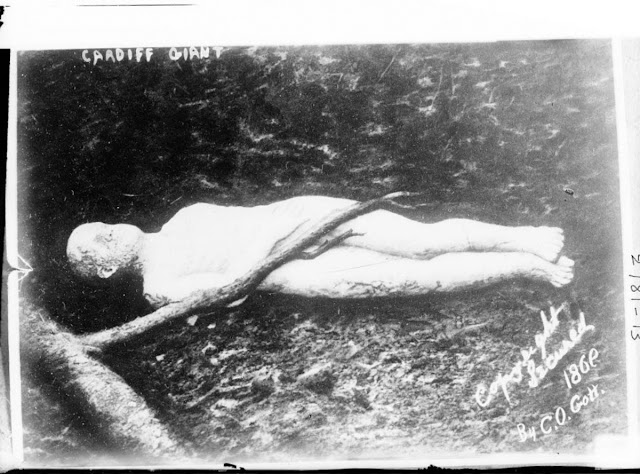The Cardiff Giant was one of the most famous hoaxes in American history. It was a 10-foot-tall (3.0 m), 3,000 pound purported “petrified man” uncovered on October 16, 1869, by workers digging a well behind the barn of William C. “Stub” Newell in Cardiff, New York. He covered the giant with a tent and it soon became an attraction site. Both it and an unauthorized copy made by P. T. Barnum are still being displayed. The original is currently on display at The Farmers’ Museum in Cooperstown, New York.
The giant was the creation of a New York tobacconist named George Hull. Hull, an atheist, decided to create the giant after an argument at a Methodist revival meeting about Genesis 6:4, which states that there were giants who once lived on Earth. Hull wanted to prove how easily he could fool people with a fake giant.
The idea of a petrified man did not originate with Hull, however. During 1858, the newspaper Alta California had published a bogus letter claiming that a prospector had been petrified when he had drunk a liquid within a geode. Some other newspapers also had published stories of supposedly petrified people.
Hull hired men to quarry out a 10-foot-4.5-inch-long (3.2 m) block of gypsum in Fort Dodge, Iowa, telling them it was intended for a monument to Abraham Lincoln in New York. He shipped the block to Chicago, where he hired Edward Burghardt, a German stonecutter, to carve it into the likeness of a man and swore him to secrecy.
Various stains and acids were used to make the giant appear to be old and weathered, and the giant’s surface was beaten with steel knitting needles embedded in a board to simulate pores. During November 1868, Hull transported the giant by railroad to the farm of his cousin, William Newell. By then, he had spent $2,600 (equivalent to $51,000 in today) for the hoax.
Nearly a year later, Newell hired Gideon Emmons and Henry Nichols, ostensibly to dig a well, and on October 16, 1869, they found the giant. One of the men reportedly exclaimed, “I declare, some old Indian has been buried here!”
Newell set up a tent over the giant and charged $0.25 (equivalent to $4.9 in today) for people who wanted to see it. Two days later he doubled the price and people still were eager to go see it. People came by the wagonload.
Archaeological scholars pronounced the giant a fake, and some geologists noticed that there was no good reason to try to dig a well in the exact spot the giant had been found. Some believed this giant was a petrified man and some believed it was a statue. Those who believed it was a petrified man thought it was one of the giants mentioned in the Bible.
Eventually, Hull sold his part-interest for $23,000 (equivalent to $471,000 in today) to a syndicate of five men headed by David Hannum. They moved it to Syracuse, New York, for exhibition. The giant drew such crowds that showman P. T. Barnum offered $50,000 for the giant. When the syndicate refused, he hired a man to model the giant’s shape covertly in wax and create a plaster replica. He displayed his giant in New York, claiming that his was the real giant, and the Cardiff Giant was a fake.
As the newspapers reported Barnum’s version of the story, David Hannum was quoted as saying, “There’s a sucker born every minute” in reference to spectators paying to see Barnum’s giant. Since then, the quotation has often been misattributed to Barnum himself. Hannum sued Barnum for calling his giant a fake, but the judge told him to get his giant to swear on his own genuineness in court if he wanted a favorable injunction.
On December 10, 1869, Hull confessed everything to the press, and on February 2, 1870, both giants were revealed as fakes in court; the judge also ruled that Barnum could not be sued for terming a fake giant a fake.
















0 comments:
Post a Comment